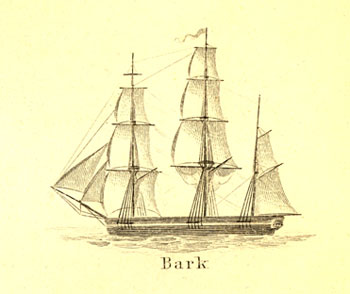
Martha's Vineyard Museum
The term bark refers to a particular sail-plan, with three (or more) masts, fore-and-aft sails on the aftermost mast and square sails on all other masts. A major advantage of the bark's rigging was that they needed smaller crews and were therefore cheaper to run. Whaling barks averaged between 250 and 400 tons, and were little more than 100 feet in length on deck. The ratio of beam to length was one to four, as opposed to one to six on clipper ships. The whaler was built for stability, not speed. It carried a large amount of specialized equipment, such as the heavy brick and iron try-works. On the port side it held three or more whale boats suspended from wooden davits, with another carried at the starboard quarter, and another at the starboard bow on larger ships. A number of features on deck were particular to the whaling bark. Around the base of the try-works was a low wooden framework, a foot or so in height called the goose pen, kept filled with sea water. Two small deck houses were built on the stern end, one for the cook's galley and the other to store the cooper's tools and supplies. The two cabins were connected overhead to provide shelter for the helmsmen at the steering wheel, in the "hurricane house." Aloft, the whaling bark differed from other ships only in that it had masthead hoops for looking out for whales. Also spelled barque or barc, the bark was the most popular type of whaleship from the 1860s to the end of the 19th century because it could sail closer to the wind with a smaller crew than a full-rigged ship.
JavaScript required access all features of this site. Use Browser Back to return.